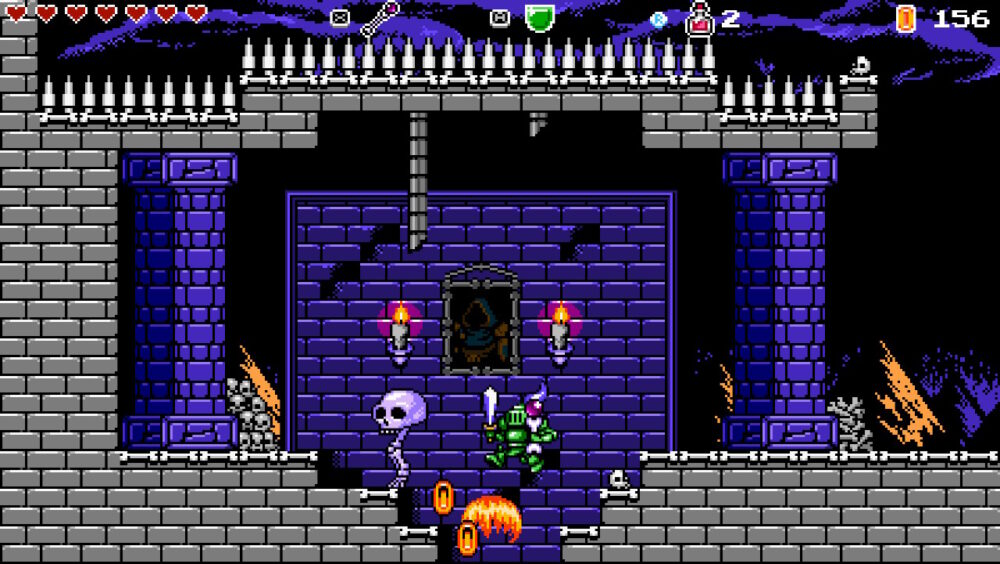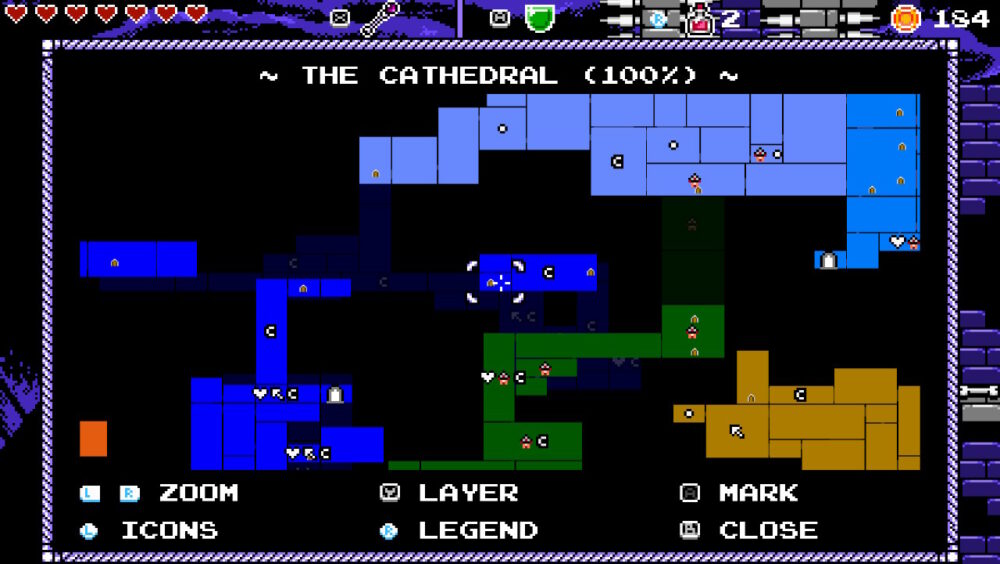Developed by Decemberborn Interactive and combining the likes of Castlevania, Metroid, Wonder Boy and Legend of Zelda, Cathedral is a lovingly made retro 8-bit Metroidvania that will pull you deep into its expansive world while testing your gaming prowess.
Cathedral doesn’t hold your hand as you wake up in the eponymous Cathedral with no memory – we assume as your character is so stoically unvocal he makes DOOM Guy seem positively chatty – and throws you into the world to explore and, hopefully, find some answers. Despite starting as simply as can be, Cathedral begins to show its storytelling moxie and RPG roots with a deeply crafted backstory for the world that will draw you in to see how it all unfolds. Across your journey you’ll travel across a wonderfully realised world full of massive dungeons, towns and some wonderfully written, quest-giving NPC’s.

Cathedral’s biggest drawcard is its world. It’s a massive, sprawling, multi-level, multi-layer map that will suck away your time with glee. Exploration is a key component of any Metroidvania title and, while the games forward path is linear, there’s still plenty of reason to go back to dungeons to explore every nook and cranny in this secret filled world once you have the right equipment. The size and scope of Cathedral often left me feeling a little overwhelmed and near constantly needing to check the games map to plot out my path. Pro-tip: if you’re looking for level transition areas between screens, zoom all the way in as you can’t see them at the standard size.

Each dungeon has its own theme and puzzles to work around. The level design is also top notch across the board, combining tricky platform challenges along with combat in ways that will test your platforming reflexes and combat skills. Thankfully your no-name protagonist is nimble on his feet and can be direction controlled in the air, making the trickier platform moments when you have to jump off one platform and do a 180 degree turn in the air to land on the platform directly above you a breeze. The inertia usually associated with platformers isn’t at play here which is fantastic as the timed platforming sections get pixel-perfect tight.

That wonderful sense of movement and speed plays into the games combat as well, as the better you become, the easier it is to jump between attacks of multiple opponents. While you’ll gain new equipment along your quest which ties into both the combat and dungeon puzzles in the best Zelda way possible, combat is still rather simple. You’ll basically be stabbing things to death while either using your arm mounted crossbow to whittle away enemy health, activate doors and platforms or help make a boss vulnerable to attack. Early on you’ll get a shield and learning to master it becomes a matter of life and death. The shield can block most enemy projectiles and some melee attacks and using it effectively really will save your hide.

Scattered across the world are the usual health and ammo upgrades, along with stackable armour upgrades. There’s a pretty good checkpoint system in the form of shrines liberally scattered across the map and fast travel points that you will need to reach to unlock. From shops in town you can buy new armour and also deposit the cash you earn from opening treasure chests and killing enemies. Depositing cash is beyond a good idea because this brings us to dying in the game. You’re going to die. You’re going to die a lot. Now this isn’t because this is a Souls-like game – even though the map shows the last place in which you were fatally perforated – but because the game becomes pretty hard in some of the later dungeons with the platforming sections specifically. The penalty for death is the loss of ten percent of the cash you’re carrying around with you. It may not seem like much, but later that amount compounds and can make that new suite of armour you want just that harder to afford.

Bosses fall into the pattern recognition category. Defeating them really is as simple as waiting for the right moment to spring your attack coupled with quick reflexes. This combination of speed and pattern recognition falls to all of the enemies in the game as well, though usually during the dungeon sections you’ll have to factor in spatial recognition as well. It’s not uncommon to fall onto a platform above a pit and have to deal with ghosts, a grim reaper and some statuary shooting fireballs at you at the same time.
Visually Cathedral replicates 8bit graphics to a tee and is, in its own way, rather gorgeous. Animations are gorgeous and many of the monsters have their own personalities that shine through in their movements, from the slime that blows snot bubbles while it’s sleeping to the grim reaper that looks embarrassed when you block his attacks.

It would be a disservice to the game for me to not mention the soundtrack which sounds like it was directly pulled from a NES. There’s a lot of variation here in style and tempo, with some really catchy beats that will stay with you long after beating the game.
With a gorgeous, massive world to explore and some truly addictive, I-have-to-beat-this-section gameplay, Cathedral shines through as an example of retro Metroidvania games done right. While not perfect, it’s as close to it as it gets and if you’re even remotely interested in this genre of side-scrolling goodness, then you owe it to yourself to pick this up straight away.
You can purchase Cathedral on the eShop for Nintendo here for £12.59 / $14.99 / €13.99
Developers: Decemberborn Interactive
Platforms: Nintendo Switch and PC
This review is based on the Switch version of the game.
Enjoy the review? want to read more of our reviews? then click right here to be whisked away to the realm of our opinions.








You must be logged in to post a comment.